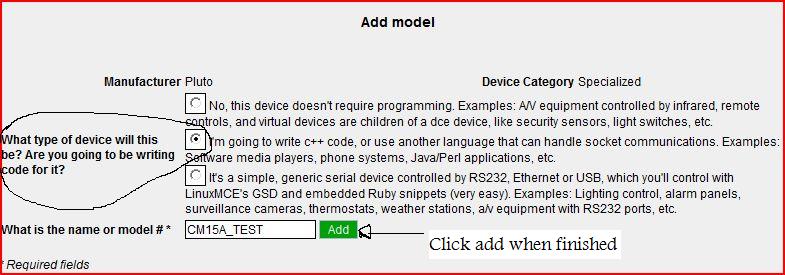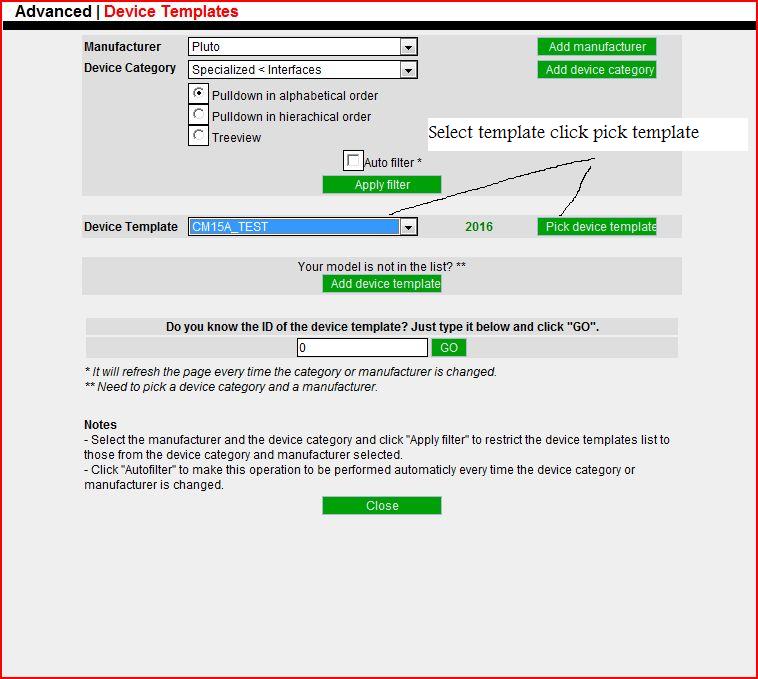Difference between revisions of "CM15A"
Mythtified (Talk | contribs) |
Mythtified (Talk | contribs) |
||
| Line 16: | Line 16: | ||
| − | A new Edit Device Template window will appear | + | A new Edit Device Template window will appear. Implements DCE should be checked. If it is not then click the check box. In the Device Category drop down box, Interfaces – Specialized #97 should be the selection shown. If it is not then click the drop down box and select it. [[Image:4_TopHalfEditDeviceTemplate.JPG]] |
Next click Add a new controlled via category device. A window will open. Click the drop down box and select Computers. Click save. [[Image:4_AddANewControlledViaCategoryDevice.jpg]] | Next click Add a new controlled via category device. A window will open. Click the drop down box and select Computers. Click save. [[Image:4_AddANewControlledViaCategoryDevice.jpg]] | ||
Revision as of 02:20, 11 December 2009
This is only valid until the code is accepted into the 0810 build
Setting up LinuxMCE for the CM15A Active Home Pro USB X10 Interface
The introduction of the CM15A to LinuxMCE was a joint venture between Nosilla_99 and Mythtified . Mythtified provided access to the hardware necessary to test the new code. Nosilla wrote and tested the code. If it had not been for Nosilla stepping up and making the time to write the code, then the CM15A would not be a reality within LinuxMCE.
The first thing to be done, ( this is very important as odd behavior could result if the file is not copied before finishing template creation ) is to copy the executable CM15A_TEST to /usr/pluto/bin. CM15A_TEST.zipOnce the file has been copied make sure it is executable. The file permissions can be changed by entering sudo chmod +x /usr/pluto/bin/CM15A_TEST from the command line in a terminal window. Once this has been done it is time to create the template that allows LMCE to talk to the CM15A.
Start by creating the template. Go to Advanced--->Configuration--->Device Templates. Once the window appears it is time to start by selecting the framework. At the top of the page, make sure that the manufacturer selected is Pluto. Below that will be the Device Category drop down. Click the drop down and select Specialized<Interfaces. Click Apply Filter and then click Add Device Template.

A window will appear to allow the initial setup of the template. Click the selection in the center: I'm going to write c++ code. Enter the name of the template in the text box and click add. The template name must match the executable name exactly, CM15A_TEST. 
The template creation window will close leaving the device template window open. Click apply filter again and select CM15A_TEST from the drop down box. Click pick device template.
A new Edit Device Template window will appear. Implements DCE should be checked. If it is not then click the check box. In the Device Category drop down box, Interfaces – Specialized #97 should be the selection shown. If it is not then click the drop down box and select it. 
Next click Add a new controlled via category device. A window will open. Click the drop down box and select Computers. Click save. 
Move down a few lines and select USB from the Comm Method drop down box. Under Device Data select Only One Per PC and click Add. In the Comments text box type only one allowed. In the Default Value type the number 1. Do not select any of the check boxes. If Plug and Play is desired perform then perform the task in the next paragraph then click Save and then click Close.
At this point either a quick reload router can be done and then set up the device manually or a little bit more can be done to the device template to make the CM15A plug and play. Confirm that the Vendor Model ID is 0bc70001 by opening a terminal window and at the command prompt type lsusb. Look for the CM15A entry and will have X10 in the description. Once the ID has been confirmed, enter the ID number in the Vendor Model ID text box. In the PNP protocol drop down box select HAL USB. Click save then then click close. Do a quick reload router and wait for the device to be created. This could take several minutes.
To set up the interface manually, click on the Interfaces link from the Wizard links on the left of the page. Click Add Device. The Pick Device Template window will open. In the Device Category drop down box select Specialized < Interfaces, then click Apply Filter. In the Device Template drop down click the CM15A_TEST template that was created earlier, then click Pick Device Template. The Pick Device Template window will close showing the Interfaces window with the newly created CM15A interface. Make sure that CORE is listed under the Controlled by heading. If it is not, click the link and choose CORE. If your installation is not on the core then you will have to figure this part out for yourself. Once this is complete then do a Quick Reload Router and wait for the interface to be installed.
Once the interface has completed installation and if the installation was successful, then a log will be created in /var/log/pluto. The log file name will start with the device id number followed by the name of the interface. Example: 37_CM15A_TEST.log.
Enjoy.